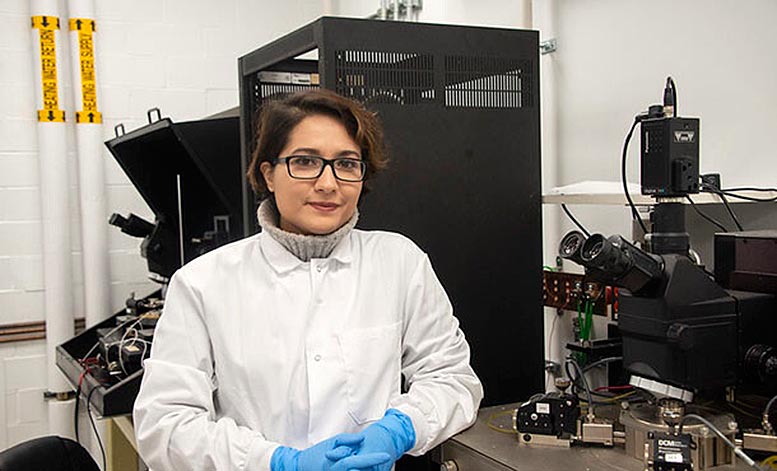Affordable Saliva-Based COVID-19 Test May Provide At-Home Results in 30 Minutes
0 View
Share this Video
- Publish Date:
- 21 October, 2021
- Category:
- Covid
- Video License
- Standard License
- Imported From:
- Youtube
Tags

Aida Ebrahimi, assistant professor of electrical engineering, recently received the National Institutes of Health, National Institute of Biomedical Imaging and Bioengineering Trailblazer Award for new and early researchers. Credit: Penn State College of Engineering
Penn State electrical engineering professor Aida Ebrahimi receives the NIH Trailblazer Award for developing a daily test device.
Current COVID-19 tests require lab processing, leading to potentially ill people going to a lab or waiting days for a diagnosis. Now, with a three-year National Institutes of Health, National Institute of Biomedical Imaging and Bioengineering Trailblazer Award for new and early researchers, Penn State researchers plan to develop an affordable and accurate at-home saliva-based COVID test. 19 test, which rivals the simplicity and convenience of pregnancy tests and glucose meters, but with a higher sensitivity.
The researchers, led by Aida Ebrahimi, assistant professor of electrical and biomedical engineering, plan to design and develop a device that can provide test results with greater than 90% accuracy within 30 minutes. The device may be sensitive enough to detect the virus before a person starts showing symptoms or in asymptomatic people, according to Ebrahimi.
To achieve this, the Ebrahimi Bioanalytical and Biosensor Lab will first use inactive SARS-CoV-2 viral particles to investigate their unique electrical properties. All materials react to an electric field, with varying reactions depending on the properties of the materials. The researchers plan to determine these detailed parameters for the inactive viral particles to design the proposed electrochemical device.
“Based on the electrical properties of the virus, we propose a dual amplification approach to achieve the sensitivity we need to detect a low number of viral particles in saliva samples,” Ebrahimi said. “We are also proposing a new method to develop the sensor that will give us that sensitivity without expensive nanofabrication tools.”
The detection device will use two simultaneous signal amplification techniques to detect viral particles, which Ebrahimi says will improve the sensitivity of the device over conventional methods. The first will apply a small voltage through a series of electrodes to trap particles, and then another, to induce an electrochemical process called redox cycling, which can amplify the signals produced by the trapped particles to a detectable level.
“The bi-amp is key — we want to have enough sensitivity to count low numbers of the virus before a person even shows symptoms,” she said. “Ultimately, the goal is for people to be able to test their saliva at home before coming into contact with other people.”
Next, the researchers will use photolithography, a cost-effective process that uses light to etch tiny patterns onto a light-sensitive surface. The cartridges are designed to capture and sort the viral target particles from the saliva sample and direct them to the sensor area.
Ebrahimi and her team will use computational modeling to guide the device design and develop the prototype, which they will test and validate using inactive virus particles. In the final phase of the project, the researchers will work with Suresh Kuchipudi, clinical professor and head of the microbiology section of the Department of Veterinary and Biomedical Sciences, to safely test the diagnostic device with intact virus samples in Kuchipudi’s lab.
“The proposed concept of the device is not limited to SARS-CoV-2,” said Ebrahimi, noting the high risk and high reward potential of the project. “If proof-of-principle of this diagnostic device and validation are successful, it could be applied to rapid quantification of biomarkers of other diseases, even outside infectious diseases such as Alzheimer’s disease. This project is only the first step towards bigger goals.”










